How To Use A Socket Wrench Set
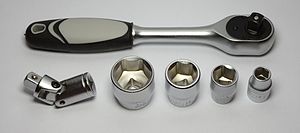
A socket wrench (or socket spanner) is a type of spanner (or wrench[i] in Due north American English), that uses a closed socket format, rather than a typical open wrench/spanner to turn a fastener, typically in the course of a nut or bolt.[2]
The most prevalent form is the ratcheting socket wrench, often informally called a ratchet. A ratchet incorporates a reversible ratcheting mechanism which allows the user to pivot the tool back and along to turn its socket instead of removing and repositioning a wrench to do and then.
Other mutual methods of driving sockets include pneumatic affect wrenches, hydraulic torque wrenches, torque multipliers and breaker bars. Some bottom known hybrid drivers include hitting wrench tools with square drive, and hydraulic impact wrenches (typically powered past on site hydraulic ability such every bit present with military tanks, and many rail motorcar applications).
The basic contemporary course of socket is hexagonal, referred to as "6-bespeak" for the pointed intersections where its 6 solid sided facets run into. These are fastened to the driving tool via a male person/female square connection plumbing equipment (called the foursquare bulldoze). Standard sizes of foursquare drives around the world include 1⁄four , 3⁄8 , 1⁄2 , three⁄4 , ane,1+ one⁄ii ,2+ ane⁄2 and 3+ i⁄2 in (vi.4, 9.5, 12.7, xix.i, 25.4, 38.i, 63.five and 88.ix mm) square drive sizes (a de facto international standard with no metric equivalents[ citation needed ]) forth with some lesser used drivers such as 5⁄8 -inch square bulldoze, and both No. iv and No. five spline drives specified in ANSI B107 specifications. This wide range of square bulldoze sizes provides for a wide variety of socket types and sizes to suit pocket-size to very big basics and bolts. Some square drivers have a through hole to adhere the socket to the commuter (using a retaining band with O-ring and pin blazon, or unmarried piece molded retaining rings), a locking pivot, or friction ball. Some common hand ratchets utilize a quick release push button on their top for quick socket release of smaller sockets. The tool chosen to drive the socket wrench ultimately supplies the mechanical advantage needed past the user to provide the torque needed to loosen or tighten the fastener as may be required. Larger drivers are typically used with higher torque, while smaller drivers are used for convenience in smaller low torque applications. Given the limits of homo strength and fatigue, torque above 800 North⋅g (600 lbf⋅ft) of torque will mostly involve some kind of ability assist, instead of the user simply pushing on the handle of a wrench. Very big sockets and drivers are typically powered by hydraulics to achieve torque.
Male drivers are also produced for utilize with socket head cap screws, and are often called Allen drivers (trademark) or the generic term male bit drivers.
The main advantage of interchangeable sockets is that, instead of a separate wrench for each of the many different fastener sizes and types, just separate sockets are needed for each size and type. Because of their versatility, nearly all screw and bolt types now have sockets of different types made to fit their bolts or nuts. Sockets frequently come as a "socket set up" with many different sizes or types of sockets to fit the heads of different-sized fasteners. A ratchet of the "set size" is often included with the socket set. Sockets are commonly available in fractional inch and metric sizes, and in curt (shallow) and longer (deep) varieties.
History [edit]
Wrenches in the grade of sockets—that is, a female driver to envelop the male head of a fastener—take existed for centuries. Early examples include the keys used to wind clocks since the Centre Ages. The heads and sockets were typically foursquare; hex heads somewhen became more mutual starting in the 20th century. The ratcheting socket wrench, with interchangeable (indexable) sockets, was invented by an American, J.J. Richardson, of Woodstock, Vermont. The tool was patented (U.Due south. Patent 38,914) through the Scientific American Patent Agency on June xvi, 1863.[three] [four] The first illustration of the tool appears on p. 248 of the Apr 16, 1864 outcome of Scientific American.[five] In current American English usage, the term "socket wrench" describes the wrench, not the socket. However, the term "socket wrench" is not used in British English[1] [2]
Foursquare heads and sockets were the easiest to make in the era when hand filing was the typical method of manufacture. With the proliferation of modernistic manufacturing methods it became just as easy to make hex heads and sockets equally square ones. The hex grade allows easier wrenching in confined environs (where nearby obstacles obstruct the swing of the wrench), because fewer degrees of arc are needed on each swing earlier information technology is possible to reposition the wrench onto the next prepare of flats. Ratchet wrenches further reduce this problem, as the wrench need just swing as many degrees as it takes for the ratchet pawl to catch the adjacent molar.
The quick release feature common to ratchets was invented and patented (U.S. Patent three,208,318) by Peter M. Roberts [half dozen]
[edit]
Fixed socket [edit]
| Prototype | Proper name | Description |
|---|---|---|
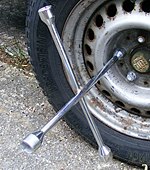 | lug wrench wheel brace | A non-ratcheting socket wrench where the socket is attached permanently to the cease of a L-shaped, or X-shaped bar. They are designed every bit special employ socket wrenches for loosening and tightening lug basics on automobile or truck wheels. |
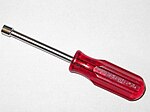 | nut commuter | A screwdriver-type handle for hand turning with a congenital-in female socket at the end of either metric or partial inch sizes. May exist of different lengths. |
 | flex-head socket wrench Saltus wrench | Combination wrenches with a stock-still socket in place of the box finish. |
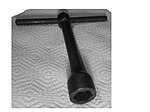 | T-handle | A socket attached to a T-handle that is used for leverage. The socket may exist fixed or sliding. |
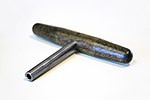 | tuning wrench | Used to melody some musical instruments' strings. |
| | spark plug wrench tube spanner box spanner | A tube with six-sided sockets on both ends. Information technology is turned with a short length of rod (Tommy bar or T-bar) inserted through two holes in the middle of the tube. Often used in situations where a common-sized fastener is recessed deep in a blind hole with minimal radial clearances for using a standard wrench/ratchet handle, such as automotive spark plugs or plumbing/tap hardware. |
Interchangeable socket [edit]
Ratcheting [edit]
| Image | Proper noun | Description |
|---|---|---|
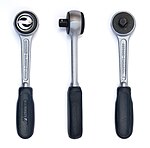 | ratcheting socket wrench | The most common type of socket wrench. The ratcheting mechanism allows the nut to be tightened or loosened with a reciprocating motion, without requiring that the wrench be removed and refitted after each turn. Typically, a minor lever on the ratchet head switches the wrench betwixt tightening and loosening mode. These drive fittings come in four common sizes: i⁄four inch, iii⁄8 inch, 1⁄2 inch, and 3⁄4 inch (referred to every bit "drives", equally in " three⁄eight drive"). Despite being denominated in inches, these are trade names (common production proper noun), and manufacturers construct them to 6.3 mm, 9.5 mm, 12.5 mm and xix mm, having been rounded to a reasonable, if haphazard, metric value. Larger drive sizes such as 1 inch and above are usually just encountered on fasteners of larger industrial equipment, such as tractor-trailers (articulated lorries), large cargo aircraft and passenger airliners, and marine work (merchant fleets, navies, shipyards). The sockets themselves come in a full range of inch and metric sizes. ("SAE" is oft used as a blanket term for the nonmetric sizes, despite the technical inaccuracy of that usage.) The advantages of the organization of a ratchet wrench with indexable sockets are speed of wrenching (it is much faster than a conventional wrench, especially in repetitive bolt-on or bolt-off usage) and efficiency of tooling toll and portability (it is much more efficient than a set of non-ratcheting wrenches, with every size head having its own handle). Fine-molar ratchets have finer teeth on the ratcheting components; these can be useful for tighter locations. Dual-pawl ratchets click twice for each tooth on the gear, effectively doubling the granularity of the mechanism. |
 | click-mode torque wrench | Commonly ratcheting and click when a preset torque is reached. Some torque wrenches have digital read-outs of torque. Other types of torque wrenches be such as torque limiting that but allows a preset torque to exist reached before they slip. For some applications, torque multiplying devices are used with a torque wrench. |
 | flex-head ratchet | Ratchets in which the drive head pivots or swivels back and forth on the handle at a pivot to the rear of the ratchet caput. |
 | hinge-caput ratchet roto-ratchet | Ratchets in which the entire ratchet head swivels with handle attachments on the side of the ratcheting caput rather than the rear of the ratcheting caput. |
| palm ratchet | Ratchets with a knurled palm sized circular ratchet handle with reversible socket zipper useful for quickly loosening or tightening a bolt or nut. They come in a variety of sizes. | |
| rotator ratchet | Allow the socket to be twisted by twisting the ratchet handle around the handle axis. Requires less than ane degree arc swing to rotate socket, which makes them ideal for very tight spaces. | |
| gearless ratchet | A ratchet that doesn't use gears, but instead uses bearings to provide nearly no arc swing nor produces an audible or discernible click. This is not commonly used as the regular geared ratchet. |
A number of other specialized ratchets—with hammer heads, multiple bulldoze sizes, and other unusual features—are built by various manufacturers.
Non-ratcheting [edit]
| Paradigm | Name | Description |
|---|---|---|
| | billow bar ability bar flexible handle | A bar that attaches to a standard socket. Breaker confined are normally longer and built more sturdily than a standard ratchet handle and accept a swiveling head that attaches to the socket. Breaker bars are used to break loose tight fasteners because their boosted length and force allows the same amount of force to generate significantly more than torque than a standard length socket wrench. The utilise of a breaker bar also avoids potential harm to the ratcheting mechanism of a socket wrench. Once the fastener is "broken loose," it tin can be turned with a socket wrench or by hand. |
 | beam-style torque wrench | Commonly not-ratcheting, made to attach to standard sockets. By monitoring the degree of beam deflection, the applied torque tin exist determined. |
| | speed handle speed brace | A crank-shaped handle that rapidly loosens or tightens a fastener when used with the correct socket. It works much like a brace and bit adapted to sockets. |
 | spinner handle socket handle | A screwdriver handle with a male drive end for attaching sockets. |
| offset drive | A fixed bulldoze where the head spins relative to the handle spinning, with the handle having a bulldoze attachment where a ratchet or other socket wrench can be fastened. |
Powered [edit]
There are also power tool versions of "air" (pneumatic) ratchets which use compressed air ability to drive air powered socket wrenches which tighten or loosen nuts or bolts. A second major variety of compressed air powered tools are touch wrenches which are used for common tasks such as lug nuts on wheels. Electric powered impact wrenches for the aforementioned tasks are not uncommon. Pocket-sized cordless 12 volt and 18 volt impact drivers are often used today as powered ratchets to remove and install nuts and bolts. Hydraulic motor ratchets with their characteristic higher torque are rare outside heavy industry. The sockets used for affect duty (chosen "bear on sockets") are fabricated with thicker walls and tempered to a lower hardness so as not to shatter under the impacts of the touch tool. They are typically finished in black oxide rather than the usual chrome plating of the paw-tool variety. Standard sockets (i.due east. non-bear upon sockets) may shatter if used with impact wrenches, presenting a safety take chances.
Socket types [edit]
There are 2 master types of sockets: impact and mitt.[ citation needed ] Sockets are referred by their number of "points" for the pointed intersections of their multi-faceted interior sides. Mutual designs include :
- 6 indicate, hexagon, for hexagonal basics.
- Variants include designs with curved (splined) faces for off nut corner contact, to reduce hazard of stripping
- 12 indicate (24 facets) for use with hexagonal nuts
-
Torx socket
-
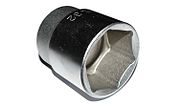
"6 point" hexagonal socket
-

Splined socket
Less oftentimes used shapes include the square 4-betoken, triple square 12-point (non to be dislocated with 12-point double hexagon), octagonal viii-betoken (non to exist dislocated with the more common 8-point double square shape). These less common shapes are typically found in special applications or particular industries such every bit shipping, PVC plumbing fittings or German and UK made automobiles. With rail cars, valve adjustment screws and piping plugs, the 4-point square shaped driver can still be constitute in wide use both male person and female configurations. Nuts and bolt heads are as well produced in 12-bespeak double hexagon shapes and various types of splines, more mutual to aircraft and aerospace applications.
When working with common 6-bespeak hexagonal fasteners, the 12-point shaped socket offers double the number of starting points or possible positions by which to put the socket on the nut, and so allows alignment every 30 degrees, rather than every sixty degrees of angle. Nearly manufacturers of sockets for larger hexagonal bolts produce them in 6-point (hexagonal) and limited sizes of 12-bespeak (double-hexagonal) configurations.
Some specialized sockets are fabricated with a specialized "6 flute" etc. socket that attaches to damaged bolts of both metric and fractional inch sizes for removal. Some specialized sockets are fabricated to fit specific specialized applications and are designed and sized for that specific awarding. Spark plug sockets, oxygen sensor sockets, ball joint sockets, axle nut sockets, etc. fit in this category.
Bear on sockets and drivers [edit]
Sockets for use with an touch wrench or impact commuter are expected to receive college torques, which is also percussive, and then need to be made of tougher materials. They are made from a thicker, tougher and more ductile alloy steel, ofttimes using CrMo steel to supersede the CrV steel used in not-impact sockets. Most impact sockets made for "standard" hexagonal fasteners have a six-point blueprint.
Chrome plated sockets are not suitable as the affect wrench may break the chrome plating, which can class razor sharp flakes - consequently touch sockets employ different coatings - often a blackness phosphate conversion blanket, or black oxide.
Standard-length and deep-length sockets [edit]

A prepare of deep sockets on a track.
Sockets are available in various depths or lengths, oftentimes divided by most manufacturers into two categories of "standard" and "deep" according to the ANSI or DIN standard they are fabricated to and the tolerances allowed by those specifications for each length of socket. Because the standards allow for some flexibility in tolerances, it is common to see two manufacturers make deep sockets of the same size but with slightly dissimilar depths even though both meet the same specification. Standard length, otherwise known equally "shallow" sockets, have a lower profile and allow a user to access nuts in narrow spaces. Deep sockets are useful for turning nuts onto bolts when the bolt extends upwards into the socket (as in the case of many bolted joints), a very typical case being frazzle clench bolts on a automobile. Low-profile sockets, shorter even than standard sockets, are bachelor for some applications, typically oil filter removal on engines with limited admission.
Although most manufacturers offering only those sizes and depths described within the common ANSI or DIN specifications, some exceptions do exist. Specialty manufacturers such as Purple-Newton Corp offer an expanded range of "actress deep" sockets for special industrial applications; and popular brands like Snap-on or Mac Tools offering what are called "semi-deep" or "mid-length" sockets, which provide much of a deep socket'south depth, while plumbing equipment in tighter locations.
Pass-through sockets and ratchets [edit]
Some sockets are designed to have the aforementioned outside diameter and shape inside a given ready size. Each pass-through socket, inside a given socket set, is designed to be used with a "special" ratchet that fits on the outside of the socket and not to the middle of the socket. By fitting the exterior of the socket they allow the commodities or stud to extend through the socket, eliminating the need for a deep socket in some applications. By attaching to the outside of the socket they likewise allow the socket to be built upwardly to l% shorter and with 20% less width which is an reward in some situations. Pass-through sockets and ratchets are built for one⁄4 -inch, 3⁄8 -inch and one⁄2 -inch sets in both SAE and metric sizes. By using a fine tooth ratchet and socket system that allow a pass-through ratchet to exist used as a conventional ratchet handle with interchangeable one⁄4 -inch and iii⁄viii -inch drives some ratchets tin can exist used with standard sockets. They are built by a number of manufacturers with a diversity of trade names. Craftsman Tools call theirs Max Axess, and also sells GearWrench's Pass-Thru brands. Lowes calls their socket system Xtreme Admission, etc.. Ratcheting box end wrenches can oftentimes exist employed in the same application, but will most e'er be significantly wider.
Drivers [edit]
Male scrap drivers are sometimes incorrectly referred to every bit "sockets", but are in fact the opposite of a socket - a socket is a female person recess or opening which receives another object. Common male bit drivers of this type include Allen hex wrenches (in both metric and fractional inch sizes), Torx (T-3 through T-l) spline wrenches, 4-signal (square), and 12-bespeak (triple foursquare) male person bit drivers. Other specialized spiral heads that are often installed or removed with screwdriver blazon handles and appropriate blazon tip have socket varieties that fit the various spiral caput types and a can be attached to a socket wrench. Conversely, for depression torque situations, a "socket spinner" screwdriver handle with a socket wrench type fitting on one finish can be attached to many different types of sockets, bit drivers and extensions.
Accessories [edit]

A typical professional grade socket set in a metal box. It contains two ratcheting socket wrenches (
1⁄four -inch and
1⁄ii -inch), various extensions for each of the wrenches, an assortment of sockets for each wrench, and a diverseness of bits fitting on the smaller wrench for different types of screws. The prototype contains annotated descriptions for each detail, visible when enlarged.
These are some of the common accessories that are used with 1⁄4 -inch, 3⁄8 -inch, ane⁄2 -inch (then on) socket wrenches:
- Extensions, sometimes called "extender artillery", attach to a socket on 1 end and a ratchet on the other end of the extension. These "extend" the length of the socket and allow admission to nuts or bolts that are difficult to reach. Extensions are typically ane⁄two to twenty inches (15 to 510 mm) in length in roughly i-to-3-inch (25 to 75 mm) increments. They are sometimes attached together to get a needed length extension, and oft take a knurled section for added grip.
- Wobble extensions have their socket attachment ends ground to allow the socket-extension interface to bend up to about 15 degrees. This additional flexibility often makes using a socket plus extension in a cramped location easier. A 1-to-1+ 1⁄ii -inch-long (25 to 38 mm) wobble extension added to the end of whatsoever extension will convert it to a slightly longer "wobble" extension.
- Extension Grip Collars are collars with indents that fit on the dorsum of nigh extensions preventing it from hands rolling away and allow one to easily grip extension and finger tighten or loosen nuts and bolts by turning extension + socket with or without ratchet.
- Ratchet spinners are curt (about i+ ane⁄2 inches (38 mm)) extensions that have a knurled attachments on them for easy paw tightening or loosening without the ratchet handle.
- Size adapters let sockets of one drive size to be used with ratchets of another drive size. They consist of a male drive fitting of one size attached to a female bulldoze plumbing fixtures of some other size. They are typically almost one inch (25 mm) long. For example, a i⁄4 -inch to three⁄8 -inch adapter allows sockets with 1⁄4 -inch drive holes to attach to a iii⁄viii -inch ratchet, and so on.
- Universal joints are two articulated socket joints (well-nigh one inch (25 mm) long) combined at a right bending, that allow a bend in the turning axis of the wrench and socket. They are used with extensions and ratchets for turning a bolt or nut at a difficult to admission location. Wobble extensions may be substituted for some universal joint applications and have the advantage of not wobbling so much.
- Crow's human foot adapters, sometimes called crowfoot adapters, feature an open end similar to a spanner along with a square hole for a ratchet or breaker bar. They are used to achieve otherwise inaccessible fastenings or to hold a tensioning nut at a specific torque whilst allowing access to a locking nut that would be inaccessible with a standard socket.
Meet as well [edit]
- Hydraulic torque wrench
- Impact wrench
- Torque wrench
References [edit]
- ^ a b Socket wrench: A wrench usually in the form of a bar and removable socket made to fit a commodities or nut Merriam-Webster
- ^ a b "Socket wrench: A ratchet tool with a series of detachable sockets for tightening and loosening nuts of different sizes." Oxford Dictionaries
- ^ U.Southward. Patent 38,914
- ^ "U.S. Ratchet patent 38914, 1863". Archived from the original on 2008-ten-12. Retrieved 2008-05-21 .
- ^ "Improved Wrench". Scientific American. Vol. x, no. 16. New York: Munn & Co. April sixteen, 1864. p. 248. Retrieved 2008-07-01 .
- ^ "Americana: Wrenching Sears". Time. 23 October 1978.
External links [edit]
- Table of American socket and nut sizes in inches
- SAE to Metric socket conversion nautical chart
- Ratchet manufacturing video
- Socket manufacturing video
- ASME B107 – specification for Socket Wrenches, Handles, and Attachments
How To Use A Socket Wrench Set,
Source: https://en.wikipedia.org/wiki/Socket_wrench
Posted by: andersontocke1979.blogspot.com

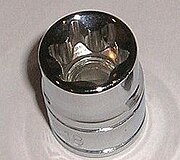

0 Response to "How To Use A Socket Wrench Set"
Post a Comment